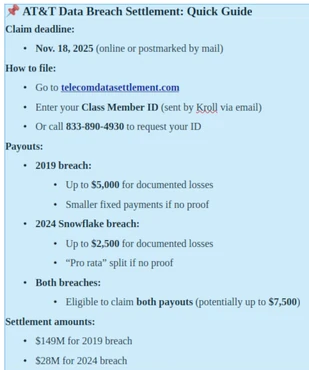The settlement pays up to $2,500 for documented users
- $177 million settlement approved: AT&T customers impacted by two massive data breaches can now file claims for compensation.
-
Deadline is Nov. 18, 2025: Those affected must submit claims online or by mail before the cutoff or risk missing out.
-
Two breaches, two payouts: One class covers a 2019 breach affecting 73 million people, the other a 2024 hack tied to Snowflake.

AT&T has been hit by two of the largest data breaches in recent history and now, nearly two years later, its customers are in line for compensation. On June 20, US District Judge Ada E. Brown preliminarily approved a $177 million settlement of a class-action privacy lawsuit arising from breaches revealed in 2024.
The settlement administrator, Kroll, began accepting claims on Aug. 4, 2025, and affected customers have until Nov. 18, 2025, to file. Those who miss the deadline will be left out.
What were the AT&T data breaches?
The settlement covers two separate breaches:
-
2019 breach (revealed in 2024): Hackers exposed Social Security numbers, birth dates, and other personal details of 7.6 million current AT&T customers and 65.4 million former account holders. AT&T reset passwords for all current customers affected.
-
2024 Snowflake breach: Hackers accessed phone records from 2022 for nearly 109 million AT&T customers. The hacker group ShinyHunters was linked to the attack, and two suspects were later arrested.
Both incidents fueled a wave of lawsuits that were consolidated in March 2025, leading to the current settlement.
How the $177 million is divided
The settlement splits into two classes:
-
AT&T 1 Data Incident (2019 breach): $149 million allocated.
-
AT&T 2 Data Incident (2024 Snowflake breach): $28 million allocated.
People impacted by both breaches can file claims for each.
What compensation looks like
Payments depend on whether claimants can prove losses:
-
2019 breach: Up to $5,000 for documented losses. Without proof, victims receive either a fixed cash payment or a smaller share depending on whether their Social Security number was compromised.
-
2024 breach: Up to $2,500 for documented losses. Without proof, compensation will be distributed on a pro rata basis.
-
Victims of both breaches may be able to claim compensation from both classes potentially as much as $7,500 if both losses are proven.
How to file a claim
Claims are managed at telecomdatasettlement.com. To file:
-
Use your Class Member ID, sent by Kroll via email (check your spam folder if you havent seen it).
-
If you didnt receive a notice, call 833-890-4930 or write to:
AT&T Data Incident Settlement; c/o Kroll Settlement Administration LLC; P.O. Box 5324; New York, NY 10150-5324. -
Submit online or download the PDF forms to mail. All mailed claims must be postmarked by Nov. 18, 2025.
Due to high demand, the claims site has used a virtual queue system. Some users have reported wait times of a few minutes to access the form.
Why it matters
AT&Ts breaches exposed sensitive personal data and affected nearly 200 million accounts in total. The legal settlement represents one of the largest consumer data breach payouts to date, and serves as a reminder of the risks customers face when major corporations mishandle personal information.
Posted: 2025-08-14 13:25:15




















